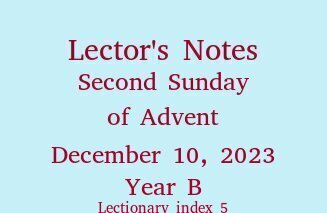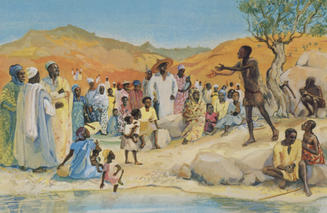

Second Sunday of Advent, year B, December 10, 2023
As their exile in Babylon ended, the people of Judah prepare to return home. Although a welcome change, the return will be a difficult, frightening journey. The second of the prophets we know as Isaiah gives reassuring words. In the last paragraph, the scene changes to nearly empty Jerusalem, where a sentinel sees God leading the exiles home.
The expectation that Christ would come again went unfulfilled for a long time. Some Christians began to doubt. This author explains that God reckons time differently, and gives ways to stay prepared.
The prophet known as John the Baptist created great controversy and had many followers. We remember him less for what he accomplished himself, more for preparing the way for Jesus.
The Historical Situation: The people of Israel spent a couple of generations in exile, captives of the Babylonians, from about 600 B.C.E. to 540 B.C.E. The second major part of the book of Isaiah, chapters 40-55, concerns the end of this Exile and the return of the captives to their homeland. Today's first reading begins that section.
The Theological Background: Isaiah says that God has told him to tell Jerusalem (that is, the exiled citizens of Jerusalem and their fellow Jews) "that her service is at an end." He means, in effect, that her "sentence" is at an end. The King James Version puts it more strongly: "Cry unto her that her warfare is accomplished, that her iniquity is pardoned." However weak or strong the translation, the meaning is that the Exile is over. Isaiah is not shy about saying the Exile was a punishment for sin, but all is forgiven now.
The Poetic Images: The next few sentences describe how the exiles are to return home. The first image is of a grand religious procession from Babylon to Jerusalem. It's not just people who are making the procession, but God as well. (Other ancient people carried idols of their gods on floats in solemn processions; Isaiah, no idolator, imagines God leading the people.) To pave the way, valleys and mountains are to be leveled, and a highway created in the wilderness.
The goal of the exiles is the region known as Judah, and within Judah the city Jerusalem, and within Jerusalem the hill Zion, where their Temple had stood. The last paragraph depicts a lonely sentry who never went to Babylon but waited in Jerusalem, always looking out for the return of the exiles. He finally sees the approach of the procession described above, and he can't contain his joy. He shouts it from the highest hill, "Here comes your God with power!" Then there follows an image in startling contrast, the tender picture of a shepherd cradling lambs.
Proclaiming It: An excellent way to prepare to proclaim this is to listen to the same verses as interpreted by George Frederick Handel, in his oratorio Messiah (1742). Within the first nine short "pieces" of the Messiah, you'll hear all these verses, set to various kinds of music, each appropriate to the text of the verses.
However you prepare, reckon with the rich array of emotions and images. Pause when there's a change in emotion or image. Modulate your voice. To revisit the classical music metaphor, note that Handel didn't render these verses in a single recitative. You shouldn't either. Rather imitate the composer, who wrote several different melodies and assigned them to a wide variety of voices.
Pause a long moment before beginning the last paragraph (verse 9), because the scene has changed. Now we're in Jerusalem, or on a hill overlooking it. The character is a sentinel who, after about sixty years of waiting, sees the returning exiles come over the horizon, God marching at their head. The watchman cannot contain his excitement!
The Theological Background:Christ will come again. We say so every Sunday. But how soon? Early Christians believed it would be very soon. The longer that expectation went unfulfilled, the more confused some Christians became. Was God failing to keep a promise? The author of 2 Peter explains that God doesn't reckon time the way we do, and that God wants to give some people a chance to prepare for the end by repenting. (Saint Paul uses a similar argument in Romans, chapters 9-11, as we saw on the 21st Sunday or Ordinary Time, year A.)
Proclaiming It: Study the passage sentence by sentence so you understand the author's reasoning. Try expressing the message in your own words, even writing out your explanation if that will help. Then, if you read this slowly to the congregation, at least some members will be able to follow the logic, too.
Secondly, speak as vigorously as the author writes. There are powerful images here. Not once but twice does he predict the cataclysmic destruction of the heavens and the elements. This is not tepid prose, and the lector need not sound tepid. Afraid you'll sound like an irreverent ham? Well, know that the acoustics and PA systems in most churches muffle most of your expressiveness. What sounds exaggerated in your own ears sounds expressive to the congregation, and that's just right. If to yourself you sound "normal," you probably sound bored and boring to the assembly. Do it vigorously. Try it once and take note of the compliments you receive after mass. You won't go back to the old way.
John the Baptist Preaching in the Desert, a work by the organization JESUS MAFA, Cameroon. JESUS MAFA is a response to the New Testament readings from the Lectionary by a Christian community in Cameroon, Central Africa. Each of the readings were selected and adapted to dramatic interpretation by the community members. Photographs of their interpretations were made, and these were then transcribed to paintings. See: www.jesusmafa.com and www.SocialTheology.com.
That explanation is from the site Art in the Christian Tradition, where you can read more, see larger versions, and gather copyright information.
This page updated November 26, 2023